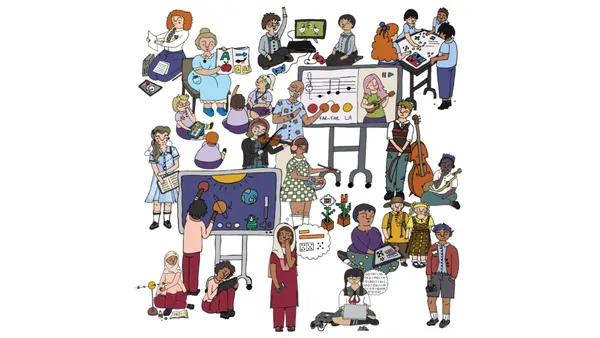Dive Brief:
- Springfield Renaissance School nurtures a positive school culture through strong bonds with adults, Edutopia reports. The school serves more than 700 students in grades 6-12, 74% of whom are nonwhite and 58% receive free or reduced lunch, with teachers and students meeting regularly in groups called “crews” for inspiration and support.
- The Springfield, Massachusetts, school’s hallways are filled with colorful banners identifying seven "community" commitments: friendship, perseverance, responsibility, respect, self-discipline, cultural sensitivity and courage. School officials say the students’ strong bonds with adults let them feel safe to take academic risks, and difficult discussions are encouraged by staff and include open dialogue and thoughtful questions.
- The efforts are paying off, with 100% of students accepted to at least one college over the last 10 years.
Dive Insight:
Administrators around the country recognize the importance of developing strong school cultures. At Fall Creek School District in Wisconsin, for example, Superintendent Joe Sanfelippo creates a “culture of yes” by being intentional about positively interacting with the students every day. He also builds trust in the community by opening the schools’ doors to everyone, especially in times of need, and makes sure that the energy he expends in the school is positive.
Hamish Brewer, principal at Fred Lynn Middle School in Virginia inspires his students with his authenticity and a splash of hall graffiti celebrating historical figures like Martin Luther King Jr. and Mahatma Gandhi. The tattooed principal is an avid skateboarder and uses boards to inspire students to succeed. He believes that all students can learn if they have the right teachers and his philosophy boils down to “don’t quit.”
Students can help shape the school culture as well. Shukella L. Price, an assistant principal at a high school in Conroe, Texas, meets monthly with a school council that includes students from all groups, not just council candidates. When learners take ownership of the school culture, she says, they tend to share the message on social media in ways that their peers can understand.
For staff, bringing the group together in different environments for professional development and doing a variety of activities, such as a cooking challenge, helps develop a sense a community and togetherness, school leaders say. These techniques can develop relationships where faculty can share ideas.





 Dive Awards
Dive Awards






